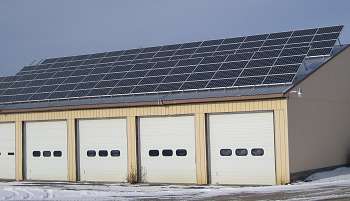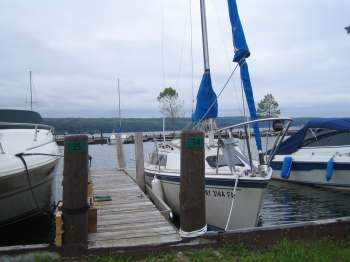- By Dan Veaner
- News
 Print
Print
With 85% of New York's population paying 8% or higher in sales tax, New York rates among the highest in the country. That makes your purchases cost more when you shop. But it benefits you when you get your local tax bills. Tompkins County is one of 43 counties that has sales tax sharing agreements with its constituent municipalities, which means Lansing received $1,409,006.70 in 2006. That amount is $321,761.70 more than the town budgeted for. "This excess sales tax money is a way that we can squirrel money away and pay for a portion of next year's expenses without impacting the tax rate," says Town Bookkeeper Sharon Bowman.

In 2005 excess sales tax revenues helped pay for solar panels
used to power Lansing's Highway Department facility
A few days before the New year, the Town Board allocated the excess revenues to four existing reserve funds, and used $10,000 of the money to establish a new technology reserve fund to help pay for computer and networking equipment. $321,761 went to the Highway Equipment Capital Reserve Fund, $165,000 to the Highway Equipment Reserve Account, $50,000 to the Parks and Recreation Equipment Reserve Account, and $76,761 to the Highway DB Fund.
Sales tax accounts for about 25% of New York counties' revenues on average, and it helps town and village budgets as well. 18 counties rely on more sales tax money than property tax, with Suffolk leading these by relying on sales tax for 46.5% of their budget. Sales tax accounts for a more conservative 21% of Tompkins County's total revenue. The County charges 4% of the 8% you pay when you purchase goods. In 2004 Tompkins County got $25,869,514 in sales tax and $29,141,576 in property tax. With a growing economy, each year the county has received more.
Tompkins County has its own formula for distributing the money to the towns and villages. From it's 4% it retains 50% of the first 3% and distributes 50% of that to towns and villages based on population. The County retains 50% of the remaining 1&, and splits the other half with 25% going to the City of Ithaca based upon income from City and the remaining 25% going to the towns and villages.

Some excess sales tax revenue is used to upgrade
and repair Lansing's marina
Lansing takes this revenue into consideration during the budget process, using historical data to estimate what revenue can be expected in the coming year. Bowman says the Town takes a conservative approach, only budgeting what it is pretty sure it will get. "Historically we have been conservative about our projections," she explains. "We never want to budget in excess of those revenues, so we take the conservative approach. It turns out to be a win-win situation, because we can take that money and reallocate it to various reserve funds or specific things that we know we need to do."
When you buy something the business submits the taxes it collects to the State Department of Taxation and Finance, either annually or quarterly, depending on how much it collects. The amount due to counties and cities is certified, then reported to the Office of the State Comptroller (OSC), which remits the money to the counties and cities. Counties then distribute portions to the towns and villages on a quarterly or monthly basis. Prior to 1993 Tompkins County kept the money to distribute annually, then changed to a quarterly approach. Last year the County began distributing the funds monthly, giving Lansing and neighboring municipalities more flexibility in how they use the money, and better ability to accrue interest.
Conservatively estimating sales tax revenues virtually insures there will be excess funding. Over the past three years this approach has worked with an average of $305,700 of excess sales tax revenue annually. "We do some calculations to insure that we keep the funds that receive the sales tax money in a healthy state," Bowman says. "Once we determine that this office makes a recommendation to the Town Board that they allocate a significant portion of that $321,000 in excess sales tax to the reserve funds that we have set up."
In a way calling the revenue 'excess' is artificial, because the amount budgeted is determined by the town based on an admitted underestimation of probable revenue. But Bowman says this method has served the Town well, helping to keep it out of debt and keeping the tax rates down. "I think it's worked well for us and allowed us to do things we otherwise would have had to borrow money for, or made the tax rate increase. And we don't want to do that. I think that's something that this board and the previous one has prided itself on, keeping the tax levy and the tax rate increase around the cost of living."
They achieved that again this year, raising the tax rate 3.76% with a cost of living rise around 4%. And while the Town could pay for everything budgeted without the excess sales tax money, it is able to do more without raising property taxes with it.
----
v3i1

In 2005 excess sales tax revenues helped pay for solar panels
used to power Lansing's Highway Department facility
A few days before the New year, the Town Board allocated the excess revenues to four existing reserve funds, and used $10,000 of the money to establish a new technology reserve fund to help pay for computer and networking equipment. $321,761 went to the Highway Equipment Capital Reserve Fund, $165,000 to the Highway Equipment Reserve Account, $50,000 to the Parks and Recreation Equipment Reserve Account, and $76,761 to the Highway DB Fund.
Sales tax accounts for about 25% of New York counties' revenues on average, and it helps town and village budgets as well. 18 counties rely on more sales tax money than property tax, with Suffolk leading these by relying on sales tax for 46.5% of their budget. Sales tax accounts for a more conservative 21% of Tompkins County's total revenue. The County charges 4% of the 8% you pay when you purchase goods. In 2004 Tompkins County got $25,869,514 in sales tax and $29,141,576 in property tax. With a growing economy, each year the county has received more.
Tompkins County has its own formula for distributing the money to the towns and villages. From it's 4% it retains 50% of the first 3% and distributes 50% of that to towns and villages based on population. The County retains 50% of the remaining 1&, and splits the other half with 25% going to the City of Ithaca based upon income from City and the remaining 25% going to the towns and villages.

Some excess sales tax revenue is used to upgrade
and repair Lansing's marina
Lansing takes this revenue into consideration during the budget process, using historical data to estimate what revenue can be expected in the coming year. Bowman says the Town takes a conservative approach, only budgeting what it is pretty sure it will get. "Historically we have been conservative about our projections," she explains. "We never want to budget in excess of those revenues, so we take the conservative approach. It turns out to be a win-win situation, because we can take that money and reallocate it to various reserve funds or specific things that we know we need to do."
When you buy something the business submits the taxes it collects to the State Department of Taxation and Finance, either annually or quarterly, depending on how much it collects. The amount due to counties and cities is certified, then reported to the Office of the State Comptroller (OSC), which remits the money to the counties and cities. Counties then distribute portions to the towns and villages on a quarterly or monthly basis. Prior to 1993 Tompkins County kept the money to distribute annually, then changed to a quarterly approach. Last year the County began distributing the funds monthly, giving Lansing and neighboring municipalities more flexibility in how they use the money, and better ability to accrue interest.
Conservatively estimating sales tax revenues virtually insures there will be excess funding. Over the past three years this approach has worked with an average of $305,700 of excess sales tax revenue annually. "We do some calculations to insure that we keep the funds that receive the sales tax money in a healthy state," Bowman says. "Once we determine that this office makes a recommendation to the Town Board that they allocate a significant portion of that $321,000 in excess sales tax to the reserve funds that we have set up."
In a way calling the revenue 'excess' is artificial, because the amount budgeted is determined by the town based on an admitted underestimation of probable revenue. But Bowman says this method has served the Town well, helping to keep it out of debt and keeping the tax rates down. "I think it's worked well for us and allowed us to do things we otherwise would have had to borrow money for, or made the tax rate increase. And we don't want to do that. I think that's something that this board and the previous one has prided itself on, keeping the tax levy and the tax rate increase around the cost of living."
They achieved that again this year, raising the tax rate 3.76% with a cost of living rise around 4%. And while the Town could pay for everything budgeted without the excess sales tax money, it is able to do more without raising property taxes with it.
----
v3i1



